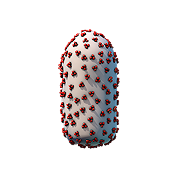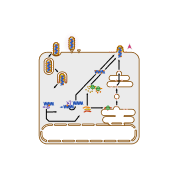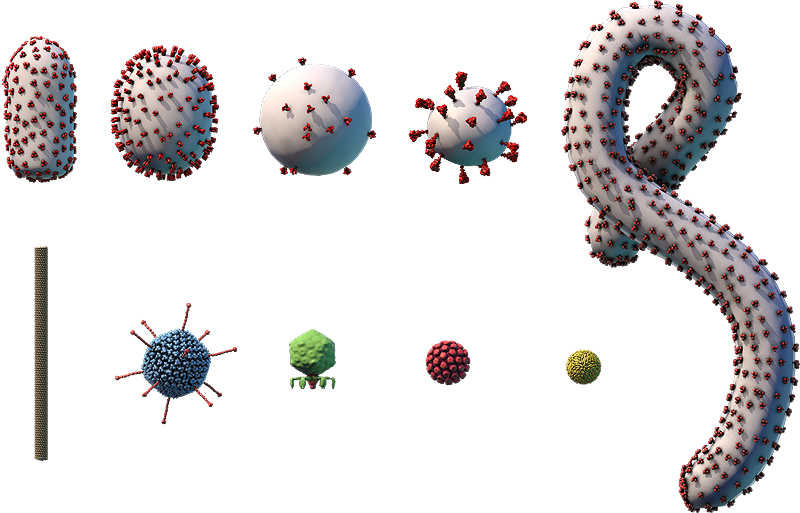Virus Explorer
Click and drag or use the buttons below to move the model.
Use the tab to focus one of the buttons above, and then space to start the rotation.
The viral envelope (gray) and proteins embedded in the envelope (red) are shown.
Components on the virus are selectively represented in the 3D model for educational purposes.
A. RNA genome; B. Nucleoprotein; C. Polymerase; D. Phosphoprotein; E. Matrix protein; F. Lipid envelope; G. Glycoprotein
This diagram shows how the rabies virus replicates, or makes copies of itself. Glycoproteins on the surface of rabies virus bind to specific receptors on the host cell’s surface (A). This triggers a process known as endocytosis (B), which brings the virus into the cell in an enclosed structure (vesicle) called an endosome. Acidic substances build up inside the endosome, lowering the pH and triggering the endosome’s membrane to fuse with the virus’s envelope. This releases the virus’s (–)RNA genome and viral polymerase into the cell’s cytosol (C).
In early stages of infection, the virus focuses on making proteins. The virus’s (–)RNA genome is transcribed into mRNA (F), which is translated into viral proteins by ribosomes in the cytosol and on the endoplasmic reticulum (ER) (G). Rabies virus glycoproteins are further modified through protein processing in the ER-Golgi network (H), then are transported to the cell membrane.
In later stages of infection, the virus focuses on copying its genome. The viral polymerase transcribes the virus’s (–)RNA genome into a complementary (+)RNA template (D). This template is used to make copies of the virus’s whole (–)RNA genome (E).
Viral genomes and proteins are assembled into new viruses (I), which leave the cell through a process known as budding (J). This process surrounds the virus in a piece of the cell membrane containing viral proteins, which becomes the virus’s envelope.
Rabies virus
- Part of the Rhabdoviridae family
- ~75-nm × 180-nm enveloped particles with a bullet-shaped helical capsid
- Linear (–)ssRNA genome of ~12,000 bp
- Infects humans, dogs, rodents, and other mammals
- Vaccine available
Rabies virus can infect a variety of hosts. The virus is most often transmitted to humans by infected dogs, but foxes, raccoons, skunks, and bats can all carry and transmit the virus.
Rabies virus causes neurological symptoms including aggression, which may lead to biting and transmission via saliva. Once symptoms occur in a human, the infection is fatal. Rabies infections are thought to occur worldwide. However, the vast majority of deaths take place in Asia and Africa.



